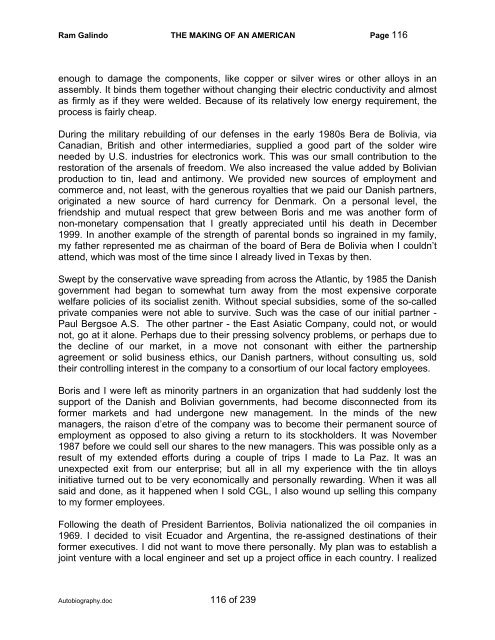Autobiography - The Galindo Group
Autobiography - The Galindo Group
Autobiography - The Galindo Group
You also want an ePaper? Increase the reach of your titles
YUMPU automatically turns print PDFs into web optimized ePapers that Google loves.
Ram <strong>Galindo</strong> THE MAKING OF AN AMERICAN Page 116<br />
enough to damage the components, like copper or silver wires or other alloys in an<br />
assembly. It binds them together without changing their electric conductivity and almost<br />
as firmly as if they were welded. Because of its relatively low energy requirement, the<br />
process is fairly cheap.<br />
During the military rebuilding of our defenses in the early 1980s Bera de Bolivia, via<br />
Canadian, British and other intermediaries, supplied a good part of the solder wire<br />
needed by U.S. industries for electronics work. This was our small contribution to the<br />
restoration of the arsenals of freedom. We also increased the value added by Bolivian<br />
production to tin, lead and antimony. We provided new sources of employment and<br />
commerce and, not least, with the generous royalties that we paid our Danish partners,<br />
originated a new source of hard currency for Denmark. On a personal level, the<br />
friendship and mutual respect that grew between Boris and me was another form of<br />
non-monetary compensation that I greatly appreciated until his death in December<br />
1999. In another example of the strength of parental bonds so ingrained in my family,<br />
my father represented me as chairman of the board of Bera de Bolivia when I couldn’t<br />
attend, which was most of the time since I already lived in Texas by then.<br />
Swept by the conservative wave spreading from across the Atlantic, by 1985 the Danish<br />
government had began to somewhat turn away from the most expensive corporate<br />
welfare policies of its socialist zenith. Without special subsidies, some of the so-called<br />
private companies were not able to survive. Such was the case of our initial partner -<br />
Paul Bergsoe A.S. <strong>The</strong> other partner - the East Asiatic Company, could not, or would<br />
not, go at it alone. Perhaps due to their pressing solvency problems, or perhaps due to<br />
the decline of our market, in a move not consonant with either the partnership<br />
agreement or solid business ethics, our Danish partners, without consulting us, sold<br />
their controlling interest in the company to a consortium of our local factory employees.<br />
Boris and I were left as minority partners in an organization that had suddenly lost the<br />
support of the Danish and Bolivian governments, had become disconnected from its<br />
former markets and had undergone new management. In the minds of the new<br />
managers, the raison d’etre of the company was to become their permanent source of<br />
employment as opposed to also giving a return to its stockholders. It was November<br />
1987 before we could sell our shares to the new managers. This was possible only as a<br />
result of my extended efforts during a couple of trips I made to La Paz. It was an<br />
unexpected exit from our enterprise; but all in all my experience with the tin alloys<br />
initiative turned out to be very economically and personally rewarding. When it was all<br />
said and done, as it happened when I sold CGL, I also wound up selling this company<br />
to my former employees.<br />
Following the death of President Barrientos, Bolivia nationalized the oil companies in<br />
1969. I decided to visit Ecuador and Argentina, the re-assigned destinations of their<br />
former executives. I did not want to move there personally. My plan was to establish a<br />
joint venture with a local engineer and set up a project office in each country. I realized<br />
<strong>Autobiography</strong>.doc 116 of 239


